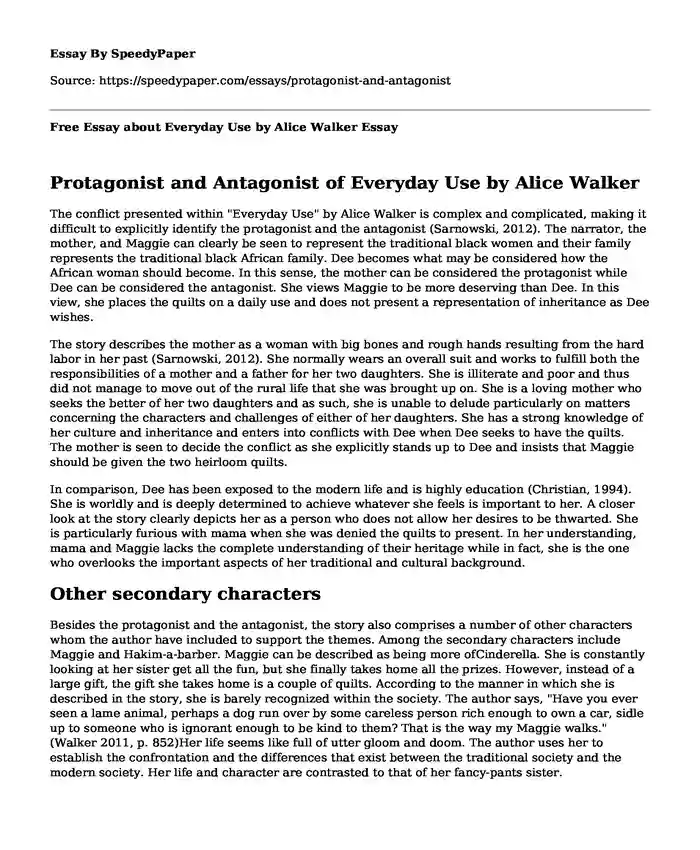
| Type of paper: | Essay |
| Categories: | Alice Walker |
| Pages: | 3 |
| Wordcount: | 693 words |
Protagonist and Antagonist of Everyday Use by Alice Walker
The conflict presented within "Everyday Use" by Alice Walker is complex and complicated, making it difficult to explicitly identify the protagonist and the antagonist (Sarnowski, 2012). The narrator, the mother, and Maggie can clearly be seen to represent the traditional black women and their family represents the traditional black African family. Dee becomes what may be considered how the African woman should become. In this sense, the mother can be considered the protagonist while Dee can be considered the antagonist. She views Maggie to be more deserving than Dee. In this view, she places the quilts on a daily use and does not present a representation of inheritance as Dee wishes.The story describes the mother as a woman with big bones and rough hands resulting from the hard labor in her past (Sarnowski, 2012). She normally wears an overall suit and works to fulfill both the responsibilities of a mother and a father for her two daughters. She is illiterate and poor and thus did not manage to move out of the rural life that she was brought up on. She is a loving mother who seeks the better of her two daughters and as such, she is unable to delude particularly on matters concerning the characters and challenges of either of her daughters. She has a strong knowledge of her culture and inheritance and enters into conflicts with Dee when Dee seeks to have the quilts. The mother is seen to decide the conflict as she explicitly stands up to Dee and insists that Maggie should be given the two heirloom quilts.
In comparison, Dee has been exposed to the modern life and is highly education (Christian, 1994). She is worldly and is deeply determined to achieve whatever she feels is important to her. A closer look at the story clearly depicts her as a person who does not allow her desires to be thwarted. She is particularly furious with mama when she was denied the quilts to present. In her understanding, mama and Maggie lacks the complete understanding of their heritage while in fact, she is the one who overlooks the important aspects of her traditional and cultural background.
Other secondary characters
Besides the protagonist and the antagonist, the story also comprises a number of other characters whom the author have included to support the themes. Among the secondary characters include Maggie and Hakim-a-barber. Maggie can be described as being more ofCinderella. She is constantly looking at her sister get all the fun, but she finally takes home all the prizes. However, instead of a large gift, the gift she takes home is a couple of quilts. According to the manner in which she is described in the story, she is barely recognized within the society. The author says, "Have you ever seen a lame animal, perhaps a dog run over by some careless person rich enough to own a car, sidle up to someone who is ignorant enough to be kind to them? That is the way my Maggie walks." (Walker 2011, p. 852)Her life seems like full of utter gloom and doom. The author uses her to establish the confrontation and the differences that exist between the traditional society and the modern society. Her life and character are contrasted to that of her fancy-pants sister.
Hakim-a-barber is described as having a lot of hair, a Muslim and may be married to Dee. Although very little information is provided in the story to enable a complete understanding of the character, he plays a significant and a crucial role in the story (Christian, 1994). For instance, the author uses the character to enable the audience to clearly understand some important characteristics of the other characters. He has direct interactions with both Dee and Maggie thus establishing some of their important behaviors and characters.
References
Christian, B. (1994). "Everyday use" and the black power movement (p. 492 - 494). New York: Pearson.
Sarnowski, J. (2012). Papers on Language and Literature. A Journal for Scholars and Critics of Language and Literature, 48 (3), 269-286.
Walker, A. (2011). Everyday Use. The Story and Its Writer (8th Ed., p. 852 - 858). Ed. Anna Charters. Boston: Bedford/St. Martin's.
Cite this page
Free Essay about Everyday Use by Alice Walker. (2022, Feb 21). Retrieved from https://speedypaper.net/essays/protagonist-and-antagonist
Request Removal
If you are the original author of this essay and no longer wish to have it published on the SpeedyPaper website, please click below to request its removal:
- Literature Review Essay Example on Time Perception
- Free Essay on Socrates' Philosophies and Business Management
- Essay Sample: Violent Video Games and Aggression in Children
- Kafka's The Metamorphosis Analysis Free Essay
- Free Essay on Review of Blackkklansman Film
- Free Essay. Public Health Risk: The Impact of Mercury
- Free Essay - Emotional Intelligence in the Workplace
Popular categories




